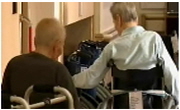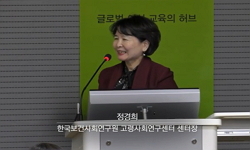(연구배경 및 목적) 한국의 고령화와 기대수명 증가로 인해 노인들의 정신적·사회적 문제가 증가하고 있으며, 여가시간의 확대로 활동 공간 부족 문제가 심화되면서 이로 인한 삶의 질 저하...
http://chineseinput.net/에서 pinyin(병음)방식으로 중국어를 변환할 수 있습니다.
변환된 중국어를 복사하여 사용하시면 됩니다.
- 中文 을 입력하시려면 zhongwen을 입력하시고 space를누르시면됩니다.
- 北京 을 입력하시려면 beijing을 입력하시고 space를 누르시면 됩니다.

고령자의 이용성 향상을 위한 선형공원의 공간요소 분석 = Spatial Element Analysis of Linear Parks to Improve Usability for the Elderly
한글로보기https://www.riss.kr/link?id=A109487962
- 저자
- 발행기관
- 학술지명
- 권호사항
-
발행연도
2024
-
작성언어
Korean
- 주제어
-
등재정보
KCI등재
-
자료형태
학술저널
- 발행기관 URL
-
수록면
343-354(12쪽)
- 제공처
-
0
상세조회 -
0
다운로드
부가정보
국문 초록 (Abstract)
(연구배경 및 목적) 한국의 고령화와 기대수명 증가로 인해 노인들의 정신적·사회적 문제가 증가하고 있으며, 여가시간의 확대로 활동 공간 부족 문제가 심화되면서 이로 인한 삶의 질 저하가 우려되고 있다. 특히 야외 공간으로서 공원에 대한 노인들의 만족도가 점차 감소하고 있는 실정이다. 선형공원은 철도 부지를 재활용하여 길게 조성된 공원으로, 다수의 출입구를 통해 여러 지역에서 접근이 용이하고, 주거 지역과 인접해 있어 교통 약자인 고령층에게 유리한 공간적 특성을 지닌다. 이러한 배경에서 본 연구는 고령자들이 선형공원을 효과적으로 활용할 수 있도록 고령친화적인 기초 자료를 도출하는 것을 목적으로 한다. (연구방법) 이를 위해 본 연구는 고령자의 여가생활과 활동 공간 부족 문제를 문헌 조사로 분석하고, 이를 토대로 체크리스트를 작성하여 서울의 대표적인 선형공원인 경의선숲길과 경춘선 숲길을 중심으로 실증적인 공간 평가를 실시하였다. 선행 연구를 참고하여 고령친화공원과 관련된 다양한 논문을 검토한 결과, 6가지 평가 차원(공평성, 안전성, 편리성, 인지성, 접근성, 쾌적성)을 선정하고, 각 차원에 대응하는 세부 평가 항목을 포함한 체크리스트를 마련하였다. 본 연구의 현장조사에서는 이 체크리스트를 기반으로 실제 공간을 평가하여, 고령친화적인 공원 요소에 대한 실증적 자료를 수집하였다. (결과) 연구 결과, 접근성, 안전성, 편리성, 공평성, 인지성, 쾌적성 순으로 공간의 요소들이 체크리스트에 부합했다. 이 결과를 토대로 고령친화적 선형공원을 위한 기본 가이드라인을 장소별로 제시하였다. 진입부는 고령자의 접근성을 높이기 위해 경사로와 충분한 보행폭을 확보하여 안전하게 설계되어야 하며, 보행로는 미끄럼 방지 기능이 있는 안전한 마감재를 사용하고, 야간에도 안전한 통행이 가능하도록 조명이 설치되어야 한다. 안내 및 경고 시설은 큰 글자와 가독성이 높은 글자체를 사용하여 시각적 편의성을 제공하고, 고령층이 쉽게 정보를 이해할 수 있도록 한다. 휴게시설은 팔걸이와 등받이가 있는 벤치를 배치하고 그늘을 제공하여 고령자가 편안히 쉴 수 있도록 해야 한다. 운동시설의 경우, 낙상을 예방할 수 있는 마감재를 사용하고 휠체어 사용이 가능한 기구를 설치하여 다양한 신체 상태를 고려한 시설이 필요하다. 특히 운동시설 기구의 추가 배치가 요구된다. 부대시설로는 안전 강화를 위해 CCTV와 비상 호출벨을 설치하고, 접근성이 높은 위치에 장애인 화장실을 배치하여 고령자의 편의를 증진해야 한다. (결론) 본 연구는 고령자의 보행 활동 증진, 고령친화적 환경 조성, 근린공원 이용 활성화를 위한 기초자료로 활용될 수 있다. 그러나 연구의 한계로는 특정 지역에 국한된 연구 대상, 응답자의 주관적 편견, 인터뷰 응답의 제한 등이 있다. 이를 보완하기 위해 다양한 지역과 대상자를 포함한 후속 연구가 필요해보인다. 또한, 다양한 공원 유형을 대상으로 한 비교 연구와 양적 연구 병행이 요구된다. 이를 통해 보다 포괄적이고 일반화된 연구 결과를 도출할 수 있을 것이다.
다국어 초록 (Multilingual Abstract)
(Background and Purpose) Due to South Korea's aging population and increasing life expectancy, mental and social issues among the elderly are rising, alongside a concerning decline in life quality due to insufficient activity spaces amidst expanding l...
(Background and Purpose) Due to South Korea's aging population and increasing life expectancy, mental and social issues among the elderly are rising, alongside a concerning decline in life quality due to insufficient activity spaces amidst expanding leisure time. Notably, elderly satisfaction with outdoor spaces such as parks is gradually decreasing. Linear parks, typically repurposed from former railway land, feature elongated layouts with multiple access points, making them easily accessible from various areas. These parks are often located near residential neighborhoods, presenting advantageous spatial characteristics for elderly individuals with limited mobility. Against this backdrop, this study aims to develop resources for elderly-friendly linear park design to enable effective use by older adults. (Method) To achieve this, the study analyzed the leisure activities and spatial deficiencies of older adults through literature review, creating a checklist based on this analysis. Focusing on two prominent linear parks in Seoul, Gyeongui Line Forest Park and Gyeongchun Line Forest Park, the study conducted an empirical spatial evaluation. A review of prior studies and literature on age-friendly parks identified six evaluation dimensions: equity, safety, convenience, legibility, accessibility, and comfort. These dimensions were then used to form a checklist of detailed evaluation items for each. Using this checklist, the field survey gathered empirical data on elderly-friendly park elements. (Results) The analysis revealed that spatial elements ranked as follows: accessibility, safety, convenience, equity, legibility, and comfort. Based on these findings, basic guidelines for age-friendly linear parks were proposed by specific area. For entryways, ramps and sufficiently wide walkways should enhance accessibility for the elderly, while walkways should have slip-resistant materials and lighting for safe nighttime navigation. Signage and warning facilities should use large, high-visibility fonts to aid accessibility, allowing the elderly to easily understand information. Rest areas should offer benches with armrests and backrests and shaded areas for comfort. For exercise facilities, slip-resistant flooring and equipment accessible to wheelchair users should be provided, with an emphasis on increasing equipment variety to accommodate diverse physical conditions. Auxiliary facilities should include CCTV and emergency call bells to enhance security, as well as accessible restrooms strategically located to improve convenience. (Conclusions) This study provides foundational data for enhancing walking activity, fostering age-friendly environments, and promoting neighborhood parks for the elderly. Additionally, it offers a basis for industry development and policy formation. However, the study is limited by its focus on specific regions, potential for subjective bias in responses, and limitations of interview data. Future research should include a broader range of regions and subjects. Comparative studies across various park types and quantitative research are also recommended for more generalized findings.
동일학술지(권/호) 다른 논문
-
- 한국공간디자인학회
- 임예슬
- 2024
- KCI등재
-
프랙털(Fractal) 특성을 적용한 형상 문법 생성 연구 - 프랙털 기하학 특성이 적용된 형상 문법 건축 조형의 미의식 중심으로 -
- 한국공간디자인학회
- 김가영
- 2024
- KCI등재
-
형태기반코드를 통한 한국 도시 사례분석에 관한 연구 -테헤란로 일대 스카이라인을 중심으로-
- 한국공간디자인학회
- 남우진
- 2024
- KCI등재
-
예비 노년층(Pre-Seniors)의‘삶의 마지막 공간’인식에 관한 주관성 연구 - Q 방법론을 중심으로 -
- 한국공간디자인학회
- 박변갑
- 2024
- KCI등재




 KISS
KISS






